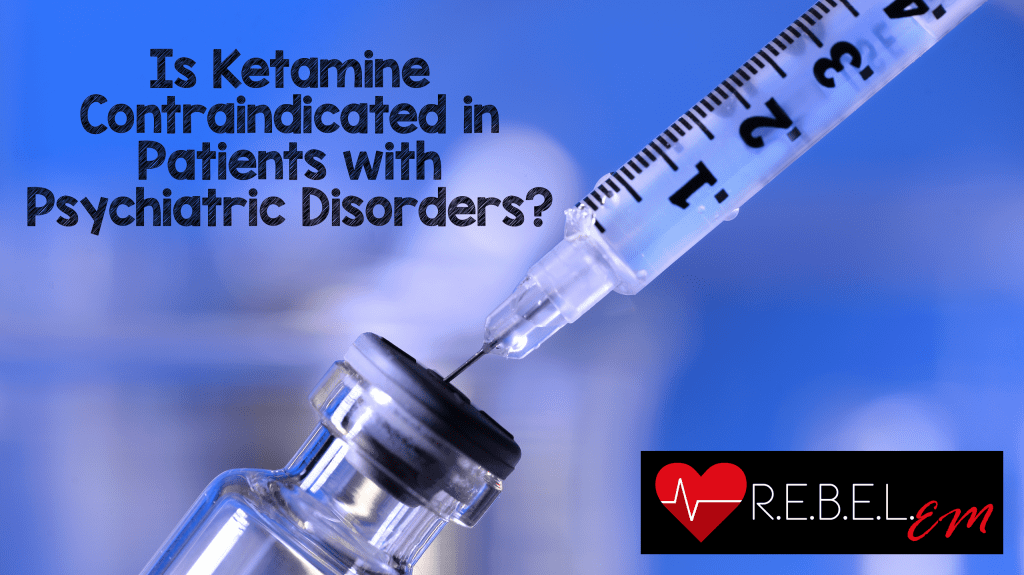 Background: In recent years, ketamine use has dramatically increased in the Emergency Department (ED). There are four major indications for the use of ketamine in the ED: analgesia with low dose ketamine (LDK), induction for rapid sequence intubation, procedural sedation and sedation of the agitated patient. A number of relative contraindications for ketamine exist though many of them have been debunked through analysis of the evidence. This includes the dogma that ketamine cannot be used in patients with head trauma (for fear of increasing the ICP) or in patients with hypertension or tachycardia.
Background: In recent years, ketamine use has dramatically increased in the Emergency Department (ED). There are four major indications for the use of ketamine in the ED: analgesia with low dose ketamine (LDK), induction for rapid sequence intubation, procedural sedation and sedation of the agitated patient. A number of relative contraindications for ketamine exist though many of them have been debunked through analysis of the evidence. This includes the dogma that ketamine cannot be used in patients with head trauma (for fear of increasing the ICP) or in patients with hypertension or tachycardia.
One contraindication that persists, though, is that of a history of psychiatric illness. Ketamine is an N-methyl-D-aspartic acid (NMDA) receptor antagonist and it can produce a broad range of cognitive and behavioral disturbances including psychosis. These disturbances are short-lived in the majority of individuals but there is a fear that ketamine can cause decompensation of psychiatric illness. The ACEP Clinical Policy lists psychiatric illness as an absolute contraindication for dissociative sedation with ketamine (Green 2011).
Clinical Question: What is the evidence behind the contraindication of a history of psychiatric illness for ketamine and how strong is this evidence?
Lahti AC et al. Subanesthetic doses of ketamine stimulate psychosis in schizophrenia. Neuropsychopharmacology 1995; 13: 9-19. PMID: 8526975
Randomized, double-blind, placebo-controlled study of 9 patients with schizophrenia. Patients were given a range of ketamine doses (0.1, 0.3 and 0.5 mg/kg) and served as their own controls. Patients were stable but had active symptoms of psychosis. Patients mental status was evaluated using the Brief Psychiatric Rating Scale (BPRS) at baseline and at various intervals after administration. After administration of ketamine, there was an increase in the BPRS score when patients received either 0.3 or 0.5 mg/kg with a return to baseline at 90 minutes. The increase in BPRS was not seen with placebo.
Conclusion: Ketamine at 0.3 mg/kg and 0.5 mg/kg increases schizophrenic symptoms in the short term with a return to baseline within 90 minutes.
Breier A et al. Association of ketamine-induced psychosis with focal activation of the prefrontal cortex in healthy volunteers. Am J Psychiatry 1997; 154: 805-11. PMID: 9167508
Randomized, double-blind, placebo-controlled study of 17 healthy volunteers without a history of schizophrenia. Ketamine was administered at 0.12 mg/kg bolus followed by 0.65 mg/kg constant infusion. Patients acted as their own controls. Patients underwent PET scans to localize the areas of the brain that were triggered by ketamine. BPRS scores increased from baseline particularly for conceptual disorganization and unusual thought context but not for hallucinatory behavior or anxiety-depression symptoms. Symptoms returned to baseline at the end of the study.
Conclusion: Ketamine transiently increases schizophrenic-type symptoms in healthy volunteers.
Lahti AC et al. Effects of ketamine in normal and schizophrenic volunteers. Neuropsychopharmacology 2001; 25: 455-67. PMID: 11557159
Randomized, double-blind, placebo-controlled study of 18 healthy, non-schizophrenic volunteers and 17 volunteers with schizophrenia (active symptoms but stable). This study had multiple arms and doses of ketamine but all within 0.1 – 0.5 mg/kg. BPRS scores were assessed at 0, 20, 90 and 180 minutes. In both healthy volunteers and volunteers with schizophrenia, BPRS score increased significantly at 20 minutes and then returned to baseline by 90 minutes. Schizophrenic patients noted that the symptoms they experienced with ketamine were similar to symptoms they experienced with schizophrenia in the past.
Conclusion: Subdissociative dose of ketamine cause a transient increase in schizophrenic symptoms in both healthy volunteers and in volunteers with schizophrenia.
Malhotra AK et al. Ketamine-induced exacerbation of psychotic symptoms and cognitive impairment in neuroleptic-free schizophrenics. Neuropsychopharmacology 1997; 17: 141-50. PMID: 9272481
Double-blind, placebo-controlled study of 13 neuroleptic-free schizophrenic patients and 16 healthy volunteers given ketamine 0.12 mg/kg bolus followed by 0.65 m/kg constant infusion and serving as their own controls. Once again, all patients experienced increased BPRS scores in the short term with resolution at 120 minutes. Auditory hallucinations were only seen in patients with a history of schizophrenia. Schizophrenic patients noted that the symptoms they experienced with ketamine were similar to symptoms they experienced with schizophrenia in the past.
While all of these studies are small, there seems to be consistency in the findings; subdissociative dose ketamine increases psychotic symptoms in all subjects – those with schizophrenia and those without. These symptoms occur soon after administration but also rapidly resolve without lasting effects. Limited evidence demonstrates that hallucinations are more likely to occur in patients with schizophrenia.
How does this impact dosing in the Emergency Department? The use of LDK for analgesia will have psychoperceptual effects in the majority patients. However, these symptoms may be more pronounced in those that have active psychotic features and may be more emotionally distressing to this group. Studies demonstrate that these psychoperceptual symptoms resolve when ketamine’s effects wear off. Due to the emotional distress these psychoperceptual features can cause in patients with significant psychiatric disease, LDK should only be used after a careful consideration of the benefits and harms of alternative analgesic agents.
The above literature does not speak to the use of dissociative dose ketamine. Dissociative doses administered for RSI or procedural sedation are unlikely to cause psychiatric distress on induction as this dose bypasses the analgesic, recreational and subdissociative dose ranges to cause immediate dissociation; a state in which the patient is unconscious. The same applies to the doses (5 mg/kg IM or 2-3 mg/kg IV) of ketamine used for sedation in severely agitated or uncontrollably violent patients. In all of these groups, psychiatric emergence reactions may be seen as ketamine is metabolized and the patient enters into partial dissociation, as external stimuli are reintegrated into consciousness. These emergence phenomena may be more distressing in patients with psychiatric disease and perhaps especially so in patients with schizophrenia. Adjunctive medications like benzodiazepines or conventional neuroleptics reduce the incidence of psychiatric distress from ketamine’s psychoperceptual effects during emergence. Providers should not be fearful that ketamine will result in prolonged (or permanent) psychosis as there is no evidence of this. A 3-year retrospective review of 18 cases of patients with active psychiatric illness (16 with schizophrenia) sedated with ketamine for transportation found no exacerbation of illness (Le Cong 2012).
Bottom Line: Subdissociative dose ketamine causes transient psychoperceptual symptoms in all patients but may be more pronounced and more distressing to patients with a history of schizophrenia. These symptoms can be ameliorated and prevented with concomitant use of conventional sedatives, and resolve without specific treatment.
In the severely agitated patient, whose agitation poses an immediate threat to themselves or others, the prospect of unmasking or exacerbating an underlying psychosis is unfounded and inconsequential. The dominating priority in these circumstances is immediately and safely achieving control of the patient, so that the threat of uncontrolled agitation is abated. Additionally, this allows providers to pivot to identifying and treating concomitant dangerous medical conditions that often present in this group. Dissociative-dose ketamine is unequalled in its ability to quickly, reliably and safely calm patients with severe agitation, and though adverse effects can occur (most importantly, hypoventilation), the presence of psychiatric disease is not a relevant concern when ketamine would otherwise be the best tranquilization agent–which, in excited delirium, it often is.
References:
- Green SM et al. Clinical practice guideline for emergency department ketamine dissociative sedation: 2011 Update. Ann Emerg Med 2011; 57(5): 449-61. PMID: 21256625
- Lahti AC et al. Subanesthetic doses of ketamine stimulate psychosis in schizophrenia. Neuropsychopharmacology 1995; 13: 9-19. PMID: 8526975
- Breier A et al. Association of ketamine-induced psychosis with focal activation of the prefrontal cortex in healthy volunteers. Am J Psychiatry 1997; 154: 805-11. PMID: 9167508
- Lahti AC et al. Effects of ketamine in normal and schizophrenic volunteers. Neuropsychopharmacology 2001; 25: 455-67. PMID: 11557159
- Malhotra AK et al. Ketamine-induced exacerbation of psychotic symptoms and cognitive impairment in neuroleptic-free schizophrenics. Neuropsychopharmacology 1997; 17: 141-50. PMID: 9272481
- Le Cong M et al. Ketamine sedation for patients with acute agitation and psychiatric illness requiring aeromedical retrieval. Emerg Med J 2011; 29: 335-7. PMID: 21565879
Expert Peer-Review: Reuben Strayer, MD emupdates.com
Post Peer Reviewed By: Salim R. Rezaie, MD (Twitter: @srrezaie)



